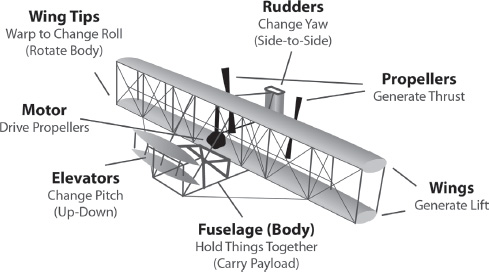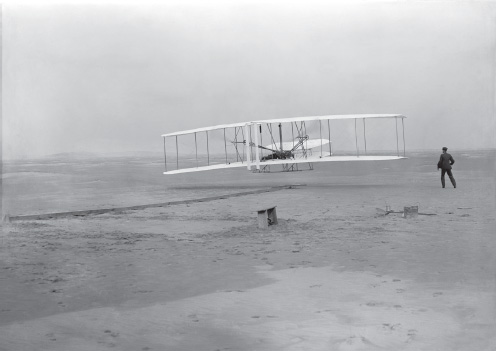3
The Power of a Personal Vision
What do people like the Wright brothers, Martin Luther King Jr., Amelia Earhart, Hellen Keller, George Washington, Rosa Parks, Gandhi, Harriet Tubman, and so many others have in common? Although none of them was perfect, the one common thread that binds them all together is they had a clear personal vision that was meaningful to them.
When you read some of these names, you may think that you will never have that kind of impact on the world. It is important to understand that your personal vision does not have to change the world; it just has to change your world! Whether you are the CEO, a frontline team member, a stay-at-home parent, or a student, you can develop a written, personal vision that is meaningful to you.
Imagine how great it would feel to have a sense of purpose, clarity, and direction. To wake up in the morning excited to face the day. High-performing employees and great leaders have such a vision. It is what provides fuel to the fire of their lives.
To use the metaphor of a seed, we believe that your personal vision is the seed of your legacy. Imagine the massive trees that grow in the redwood forest. They can be up to 240 feet high and up to 15 feet in diameter, and every one of those giant trees started as a small seed. Likewise, most great accomplishments start with the seed of an idea.
You have likely heard about creating a personal vision many times throughout your life. However, in our research, we have found that it is talked about a lot more than it is done. In fact, as we shared earlier, only 2 percent of the people we surveyed had a written personal vision. In this chapter and the next, we want to help you plant your seed and develop a compelling written vision that is meaningful to you.
When it comes to performance and productivity, one of the most important things a person can do is to articulate their vision. Imagine, from a managerial perspective, how great it would be to have a team of people, where each member is clear on their direction and purpose; is engaged; has a desire and passion for being there; and has a personal vision that aligns with the team and organization. The process of developing a personal vision can be transformative both for the person and for the entire team.
The unique approach to developing your vision shared in this chapter and the next will help you establish a well-rounded vision that will impact all aspects of your life!
The Wright Brothers
Before we get started on your personal vision, let us examine the Wright brothers to see what impact their vision had in changing the course of history. Their vision gave them the direction, motivation, and encouragement to successfully design and fly the first aircraft—a feat that changed the world.
So, what was their vision? To successfully build and develop a flying machine!
It is interesting to see how this vision came about. The Wright brothers first conceived the idea that man could fly in August of 1896. Keep in mind that Orville and Wilbur did not even understand the principles of flight at this point. That August day was important because once they conceived the thought—the seed of the idea—it was the beginning of what ultimately became a powerful vision. It was their vision that guided their behavior, focus, learning, and time. And it was this vision, coupled with their background and ingenuity, that made modern flight a reality.
Only after they conceived the vision to fly did they work on how to fly—first the vision, then the reality. It is the same with us; we first need to develop the vision, then we can work on the how-to. The following is a brief background of the Wright brothers and how their vision led to manned flight.
Wilbur (1867–1912) and Orville Wright (1871–1948) were raised in Dayton, Ohio. One day, their father brought home a small toy helicopter made of wood. It had two rubber bands that, when twisted, turned a small propeller. Wilbur and Orville played with it until it broke; then they made new copies of the toy themselves. They began to make additional toy helicopters and sell them to their friends. Thus, their newfound curiosity and innovation led them into the world of flight.
Years later, the Wright brothers opened their first bicycle shop. Initially, they sold and repaired bicycles. They would replace spokes, fix broken chains, and sell accessories. Then in 1896, they began to build their own brand of bicycles. All of their bicycle experience helped them in their investigations of flight. They used the technology they learned from their bicycle business in their airplanes: chains, sprockets, spoke wires, ball bearings, and wheel hubs. Their thoughts on balancing and controlling their aircraft were also rooted in their experience as cyclists.
In 1900, they built their first machine designed to carry a pilot and chose Kitty Hawk, NC, as a suitable testing ground. With its strong, steady winds, open areas, and tall sand dunes, it was perfect for their experiments. When their initial aircraft design produced less lift than expected, the Wright brothers flew it as a kite and gathered more information that would enable them to design improved machines. They needed more practice, so they developed what they called a “wind tunnel” to help them simulate the conditions of flight while they worked to improve the design.
In 1902, using the wind tunnel, they discovered that to solve the control problems, they needed to add a rudder (see Figure 7). Discovering the importance of a rudder was one of the breakthroughs they needed to be able to fly successfully.
Figure 7. A diagram of the Wright Flyer

At Kill Devil Hills, on December 17, 1903, at 10:35 a.m., the Wright Flyer took off under its own power with Orville as the pilot (see Figure 8). It flew for 12 seconds and went about 100 feet. Orville and Wilbur took turns making three more flights that morning. Wilbur was at the controls for the fourth and longest flight, traveling about 800 feet in 59 seconds. The Wright 1903 Flyer became the first powered, heavier-than-air machine to achieve controlled, sustained flight with a pilot aboard. Today, this amazing flying invention can be seen at the National Air and Space Museum in Washington, DC.
In subsequent years, the Wright brothers continued to make modifications and improvements, until they got to the point where they could repeatedly bank, turn, circle, and do figure eights with their flyers. On two occasions, their flights exceeded half an hour. Wilbur and Orville Wright, brilliant self-trained engineers, had overcome complex technical problems that had barred the way to mechanical flight for centuries.15
Imagine the power of that single vision and the impact it had on the next century!
Figure 8. First flight16

Naysayers likely told the brothers that what they were doing could not be done. They had hundreds of setbacks, and like most innovators, they were likely tempted to quit at different points on their journey. But their vision was clear, and it provided them with a well of motivation and direction.
It was the combination of their mindset and skillset that helped them turn the impossible into the possible.
Although we used the Wright brothers to illustrate the power of a vision, we will repeat this: your vision does not need to change the world, it just needs to change your world!
The Influence of a Personal Vision
Nearly everyone agrees that it is important to align a team and an organization with a clear vision. Well, if it is critical for a team to be aligned with a vision, isn’t it also important for each of us to have a vision that creates alignment in our personal and professional lives?
In the Wright brothers example, you saw something that changed the world; now let’s use a couple of personal examples to illustrate how a personal vision can also change your world.
• • • •
We had just finished leading a two-day conference in Johannesburg, South Africa. At the time, one of the participants, named Jeff (who has since become a close friend), explained that he was leading an organization of approximately 2,000 employees. It was evident to us from his demeanor and the way he talked that he genuinely cared about his employees and the success of his organization.
During the conference, it became apparent that Jeff had endured several personal trials during the prior year and that they had tested him to the core. He shared that he was at a real low point in his personal life and that the things he was dealing with personally were also taking a significant toll on his ability to lead his company effectively.
After the conference was over, people left, except Jeff. While we were taking down the equipment, Jeff walked up behind us and placed a pack of cigarettes on a nearby chair. We turned around, saw Jeff standing there with moist eyes, and asked him what was going on. Jeff responded, “For years I have wanted to stop smoking cigarettes. I have smoked more than a pack a day, sometimes two, for a long time. Finally, it was when I developed my vision that I realized cigarettes were no longer a part of my future. This pack [pointing to the partially empty pack of cigarettes] is the last pack of cigarettes I will ever use. My vision has changed!” He had discovered that his internal why was now big enough to take on the challenge that had eluded him for years. We embraced in a big hug and congratulated him on his new-found vision and motivation.
Jeff related that he had thought about quitting smoking for years. The same exercise you will use in the next chapter to develop a personal written vision is the one that finally gave Jeff the internal drive to make a change. Implementing the big three became a turning point in Jeff’s life. It was his focus on his vision, his roles and goals, and his pre-week planning that turned him around and helped him reconnect with a purpose. When you go through the same process of developing your vision, you will likely feel a similar internal desire for improvement.
What is powerful about a vision is that when we have one, we intuitively know when our life is either in alignment or out of alignment with this vision. When our lives are out of alignment with our vision, it is our responsibility to get back into alignment—just like Jeff did on that day in Johannesburg.
• • • •
In a more personal example, we will share how a personal vision changed Rob’s life when he was 16 years old, shortly after his junior year in high school. That year was tough for him while he was trying to figure out life; he felt lost and confused. His confidence was low, he did not have any direction, and he certainly was not motivated. But everything changed on a warm July evening. It happened when he and his brother Steven attended the Stadium of Fire in Provo, Utah—one of the largest Independence Day celebrations anywhere in the United States.
The festivities kicked off with a fantastic fly-by of four F-16 fighter jets, which is always a great experience. When the jets flew by, everyone felt the roar of the engines reverberate through their bodies. Rob and his brother watched in awe while the jets flew over in perfect formation. Rob and Steven looked at each other and agreed, “Someday we’re going to fly those jets over this stadium.”
That warm July evening, focus and clarity came into Rob’s life—the seed was planted, and the beginning of his vision was born!
From that point forward, Rob committed to act on that vision to become a fighter pilot. A wayward and lost teenager now had a laser-like focus, and everything changed in his life. He went to work on the plan to achieve his vision. He knew he would need to graduate from high school, do well at the university level, and compete with a lot of cadets for a coveted pilot slot. At 17 years old, after the required flight lessons, he earned his pilot’s license, which further fueled his internal flame to become a fighter pilot.
Many years later, both Rob and Steven became F-16 pilots in the United States Air Force. After years of preparation and hard work, they were much closer to making their vision from the Stadium of Fire a reality.
Fifteen years after sitting in the stadium as young teenagers, Rob and Steven applied to the Pentagon for approval to do the fly-by for the Stadium of Fire. Fortunately, the Pentagon approved their request. Although each of them had experienced some pretty amazing things during their fighter pilot careers, they knew this fly-by would be the proverbial icing on the cake.
On July 4, 2007, their vision became a reality. Rob and Steven, in a four-ship formation, opened the celebration and performed the fly-by for the Stadium of Fire. In Figure 9, you can see a picture from Rob’s jet looking at Steven’s jet on the far side of the formation.

After they flew over the stadium, the ground controller came over the radio and said, “Nice fly-by. Perfect timing. Congratulations, Shallenbergers!” The hair on both of their arms stood up, and both felt tears in their eyes. It was a special moment for everyone involved. Their entire family was in the stadium watching, many also with tears streaming down their cheeks.
It was the seed of their personal vision that was planted when Rob was 16 years old that led to this memorable experience. At 15 years to the day, his vision became a reality!
No matter what your vision is, once you have it, it becomes the spark that ignites the fire inside. Once you have your vision, you are able to develop your roles and goals and consistently do pre-week planning to work toward accomplishing that vision.
Create the Mental Reality Before the Physical Reality
One of the biggest challenges when we develop a vision is getting past the hurdle between our ears—our mindset. One of the most important things you can do in the process of developing your vision is let the creative ideas flow and not worry about all the constraints and roadblocks of what is and is not possible.
Let’s equate the importance of the mindset to designing and building your dream home. Imagine in your mind’s eye the look and feel of your dream home. Envision yourself driving up to your finished home, walking to the front door, and entering the home. Imagine looking in the main room and admiring every feature. In your dream home, you have had no constraints. You have been able to build whatever you want. Imagine looking at the woodwork, the landscaping, the beautiful kitchen, and the living room. What do you see?
Now, let’s backtrack and think about what you need to build this home. At a minimum, you need money, property, and a plan (like the one you might see in Figure 10).
Figure 10. Dream home schematic

Would you build your home without a blueprint or plan? Of course not! Without a solid plan, the home may not meet code, you may have costly overruns and miscommunicate with contractors, and undoubtedly, the home would turn out differently than you had envisioned.
When you have a plan, you can see everything beforehand. You can see the result in your mind’s eye before the house is even built. You can go over the plans with your partner and family to be sure everyone agrees. And, once you begin construction, the plan serves as a communication tool to be sure everyone is aligned.
If you only had one shot at building your dream home, you would be meticulous about your plans. Likewise, we only get one shot at life, so how important is it to have a solid plan for it?
When building your dream home, you use your imagination to create the thought, or mental picture, of the home. Then, you get to work on actually building and constructing it.
Your personal vision is about creating the mental reality before the physical reality. Once you dream it, then you can achieve it. Once you have it clear in your mind’s eye, then you become intently focused on it. The journey of life gets exciting when you can get up in the morning and know what your best looks like because you have seen it in your mind’s eye. Your personal vision will add direction, texture, light, color, imagination, music, richness, and amazement to your life.
A Clear Vision Can Transform Your Life
A vision has preceded almost every great accomplishment throughout history. Think of these famous visions:
![]() John F. Kennedy—Put a man on the moon.
John F. Kennedy—Put a man on the moon.
![]() Rosa Parks—Equality for all.
Rosa Parks—Equality for all.
![]() Elon Musk—Put people back into space, colonize the moon, go to Mars.
Elon Musk—Put people back into space, colonize the moon, go to Mars.
![]() Amelia Earhart—Be the first woman to fly alone across the Atlantic.
Amelia Earhart—Be the first woman to fly alone across the Atlantic.
![]() Bill Gates—Have a computer in every home.
Bill Gates—Have a computer in every home.
Each one of these influential leaders were guided by their vision. Successful leadership is about leading a life by design rather than living a life by default!
From the managerial perspective, leadership is about bringing out the best in others. One of the best ways to lead your life, and bring out the best in your team, is to first have your own inspiring personal vision and then help each person on your team develop theirs.
In his legacy book Good to Great, Jim Collins talks about getting your people in the right seats on the bus.17 Think about how much easier it is to get a person in the right seat when you, as the leader, understand their talents, strengths, and especially their vision. In most cases, a team member whose personal vision is in alignment with the team and organization is a better contributor and a higher performer.
Likewise, focusing on teams is what successful executives and leaders do. Imagine the power of a team in which each person has a written personal vision that inspires them and brings out their best. Even better is a team made up of people who have inspiring personal visions, who develop their roles and goals, and who consistently do pre-week planning. The odds are that this will be a high-performing team because its members are well-versed on high-performance habits!
To take it a step further, if you are a parent, imagine helping your children develop a written vision that is meaningful to them. Leadership in the home is just as important, if not more important, than leadership in the workplace.
From the parenting perspective, Steve and his wife Roxanne tried to provide their children with opportunities that allowed them to see and learn new things. Steve and Roxanne believed that one of the serendipitous things in life is that in the right moment, providence would move on their behalf, and their children would each have a moment to capture a vision or dream that would have a profound influence on each of their lives.
Remember how Rob and Steven were inspired while sitting in the Stadium of Fire watching the F-16 fly-by? Another example of this type of inspiration resulted from when Steve took his children to the county and state political conventions when they were young. One of his sons, David, still has photos that he took with elected officials when he was just 12 years old. David was so impressed with public service that 30 years later, he got involved with politics at the state level. He, too, captured a vision about becoming a public servant, and years later, he is acting on that vision.
Similar things happened with Steve’s other children. Each one was shown ideas, seized an inspiration, identified a course of action aligned with their strengths, and formed a personal vision that had a deep impact on each of their lives. Of course, none of the children is perfect, but what came from their personal visions has changed their lives as well as the lives of many others.
In one final example of leadership in the home, as part of her vision, Roxanne (in the role of mother) wanted each of her children to learn how to play the piano. Steve was excited about this vision and fully supported her efforts to find a teacher and, later, to shuttle the children to their many lessons and to help them practice and learn to play. As a result of her vision and hard work, all six of Steve and Roxanne’s children learned to play the piano. This tradition has continued with Steve and Roxanne’s grandchildren, who are all currently playing or learning how to play the piano. This type of legacy did not happen by accident. It was Roxanne’s vision, leadership, motivation, and encouragement that created it.
Taking someone’s native interests, helping them plant the seeds, and encouraging them to cultivate those seeds is one of the greatest gifts you can give them—whether you are in the workplace or in the home, this is the essence of leadership!
Wrap Up
The famous lecturer and poet Ralph Waldo Emerson wisely said, “What lies behind you and what lies in front of you, pales in comparison to what lies inside of you.” A personal vision is exponentially more powerful when it is founded on character and correct principles. Each of our personal visions is about more than the destination; it is also about who we will become in the journey toward the destination.
Your personal vision, which lies inside of you, will change your world and all those around you as it deeply blesses and influences your life for good.
Developing a written personal vision is the first of the big three habits that are such strong predictors of high productivity and success. Once finished, your vision will become a wellspring of motivation and serve as your internal compass. It will become the guide for your roles and goals, and then later, for your pre-week planning.
Now, let’s get started on how to develop your personal vision!
